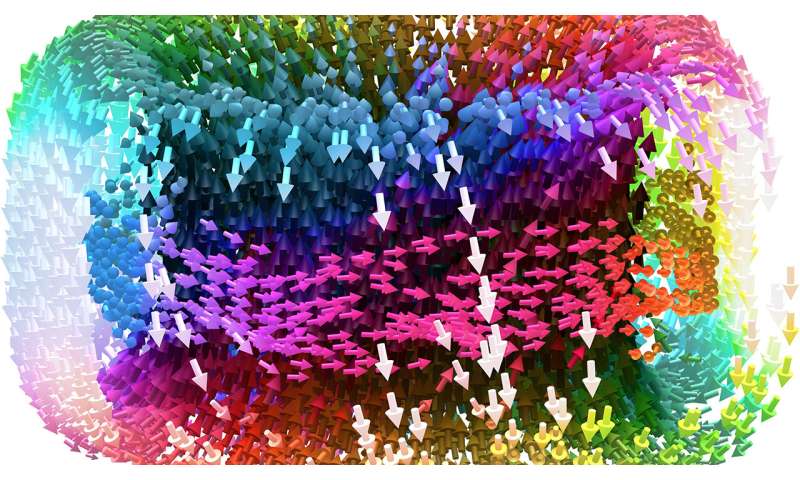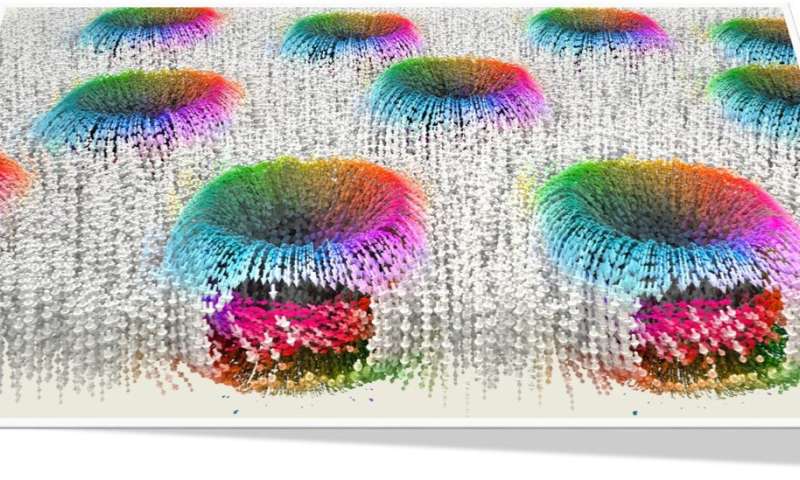April 18, 2019 report
Researchers report observation of room-temperature polar skyrmions
![Observation of ordered polar structure. a, b, Cross-sectional dark-field TEM images of a (SrTiO3)16/(PbTiO3)16/(SrTiO3)16 trilayer (a) and a [(SrTiO3)16/(PbTiO3)16]8 superlattice (b), revealing a regular in-plane modulation of about 8 nm. c, d, Planar-view dark-field STEM imaging shows the widespread occurrence of nanometre-size round and elongated features in a (SrTiO3)4/(PbTiO3)11/(SrTiO3)11 trilayer (c) and only circular features in a [(SrTiO3)16/(PbTiO3)16]8 superlattice (d) along the [100] and [010] directions. The STEM studies were repeated in a minimum of 10 separate samples and the observations were repeatable. Insets, FFT of the images in c and d show a ring-like distribution with stronger intensities along the cubic directions—the same feature seen in RSM studies. Credit: Nature (2019). DOI: 10.1038/s41586-019-1092-8 **Researchers report observation of room-temperature polar skyrmions](https://scx1.b-cdn.net/csz/news/800a/2019/5cb848c8cd196.jpg)
An international team of researchers has discovered a way to create and observe room-temperature polar skyrmions. In their paper published in the journal Nature, the group describes creating the polar skyrmions and their observations. Pavlo Zubko, with the London Centre for Nanotechnology, has published a News and Views piece on the work done by the team in the same journal issue.
Zubko describes skyrmions as "tiny whorls of magnetic moments," and notes that a lot of research has been done with them because they are very useful in data storage applications. But he also notes that finding electrical versions of skyrmions has been a difficult journey. That may change, however, as the researchers with this new effort report a way to create and observe at least one kind of electrically based skyrmion—the polar skyrmion.
Zubko notes that the researchers started with the observation that ferroelectrics and ferromagnetics, despite being very different, have some basic similar properties—spontaneous magnetization and polarization are just one example. He suggests it is this property that makes both such a draw for data storage applications. He also notes that scientists have been searching for some time for polarization in ferroelectrics that rotate in a way that could lead to the creation of skyrmions. Prior work has shown that when ferroelectrics are confined at the nanoscale, they become more sensitive to stresses and electric fields, which can upset polar orientation and give way to dipoles. In such scenarios, small regions of dipoles with the same orientation can form spontaneously and those regions will have boundary walls separating them from other regions.
-

Simulation of a single polar skyrmion. Red arrows signify that this is a left-handed skyrmion. The other arrows represent the angular distribution of the dipoles. Credit: Xiaoxing Cheng, Pennsylvania State University; C.T. Nelson, Oak Ridge National Laboratory; and Ramamoorthy Ramesh, Berkeley Lab -

Army-funded research discovery may allow for development of novel device structures that can be used to improve logic/memory, sensing, communications, and other applications for the Army as well as industry. Image demonstrates simulation of emergent chirality in polar skyrmions for the first time in oxide superlattices. Credit: Xiaoxing Cheng, Pennsylvania State University; C.T. Nelson, Oak Ridge National Laboratory; and Ramamoorthy Ramesh, University of California, Berkeley
In their work, the researchers noted that the domain walls had polarization components that were perpendicular to those that resided next to them. They found that all it took was looping a domain wall between regions to force a ring of polarization to develop, which led to the creation of bubbles—polar skyrmions. The team then used an electron microscope that was capable of showing atomic displacement to observe the skyrmions. They further report that X-ray diffraction of the skyrmions showed them to have macroscopic chirality. Zubko suggests that much more work will need to be done with the skyrmions to find out if they will work with real-world applications, such as racetrack memory devices.
More information: S. Das et al. Observation of room-temperature polar skyrmions, Nature (2019). DOI: 10.1038/s41586-019-1092-8
Journal information: Nature
© 2019 Science X Network





















